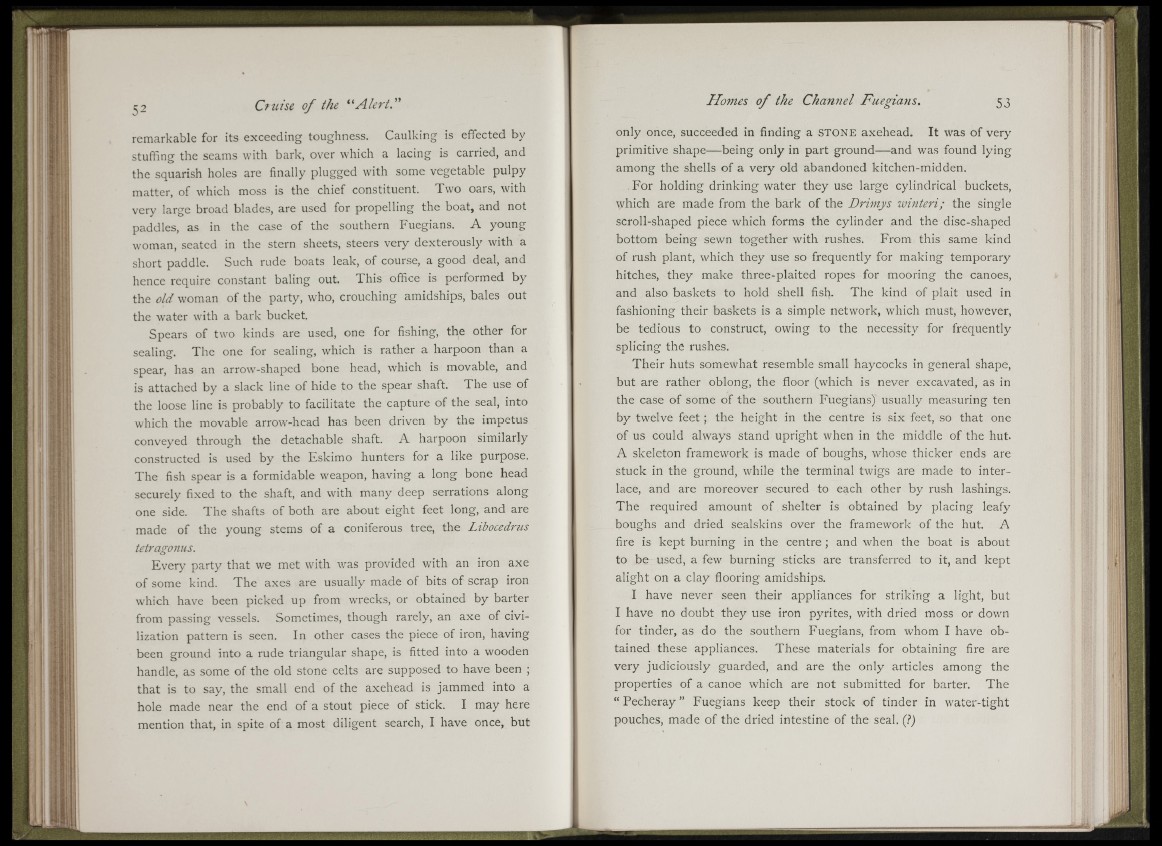
1 1 I
! !ii P
|i!
;.! l!
i i '.ri
-- s
1. 'h •!
remarkable for its exceeding toughness. Caulking is effected by
stuffmiT the seams with bark, over which a lacing is carried, and
the squarish holes are finally plugged with some vegetable pulpy
matter, of which moss is the chief constituent. Two oars, with
very large broad blades, are used for propelling the boat, and not
paddles, as in the case of the southern Fuegians. A young
woman, seated in the stern sheets, steers very dexterously with a
short paddle. Such rude boats leak, of course, a good deal, and
hence require constant baling out. This office is performed by
the old woman of the party, who, crouching amidships, bales out
the water with a bark bucket.
Spears of two kinds are used, one for fishing, the other for
sealing. The one for sealing, which is rather a harpoon than a
spear, has an arrow-shaped bone head, which is movable, and
is attached by a slack line of hide to the spear shaft. The use of
the loose line is probably to facilitate the capture of the seal, into
which the movable arrow-head has been driven by the impetus
conveyed through the detachable shaft. A harpoon similarly
constructed is used by the Fskimo hunters for a like purpose.
The fish spear is a formidable weapon, having a long bone head
securely fixed to the shaft, and with many deep serrations along
one side. The shafts of both are about eight feet long, and are
made of the young stems of a coniferous tree, the Libocedrus
tetragonus.
Fvery party that we met with was provided with an iron axe
of some kind. The axes are usually made of bits of scrap iron
which have been picked up from wrecks, or obtained by barter
from passing vessels. Sometimes, though rarely, an axe of civilization
pattern is seen. In other cases the piece of iron, having
been ground into a rude triangular shape, is fitted into a wooden
handle, as some of the old stone celts are supposed to have been ;
that is to say, the small end of the axehead is jammed into a
hole made near the end of a stout piece of stick. I may here
mention that, in spite of a most diligent search, I have once, but
only once, succeeded in finding a STONE axehead. It was of very
primitive shape— being only in part ground— and was found lying
among the shells of a very old abandoned kitchen-midden.
For holding drinking water they use large cylindrical buckets,
which are made from the bark of the Drimys zuinteri; the single
scroll-shaped piece which forms the cylinder and the disc-shaped
bottom being sewn together with rushes. From this same kind
of rush plant, which they use so frequently for making temporary
hitches, they make three-plaited ropes for mooring the canoes,
and also baskets to hold shell fish. The kind of plait used in
fashioning their baskets is a simple network, which must, however,
be tedious to construct, owing to the necessity for frequently
splicing the rushes.
Their huts somewhat resemble small haycocks in general shape,
but are rather oblong, the floor (which is never excavated, as in
the case of some of the southern Fuegians) usually measuring ten
by twelve feet ; the height in the centre is six feet, so that one
of us could always stand upright when in the middle of the hut.
A skeleton framework is made of boughs, whose thicker ends are
stuck in the ground, while the terminal twigs are made to interlace,
and are moreover secured to each other by rush lashings.
The required amount of shelter is obtained by placing leafy
boughs and dried sealskins over the framework of the hut. A
fire is kept burning in the centre ; and when the boat is about
to be used, a few burning sticks are transferred to it, and kept
alight on a clay flooring amidships.
I have never seen their appliances for striking a light, but
I have no doubt they use iron pyrites, with dried moss or down
for tinder, as do the southern Fuegians, from whom I have obtained
these appliances. These materials for obtaining fire are
very judiciously guarded, and are the only articles among the
properties of a canoe which are not submitted for barter. The
“ Pecheray ” Fuegians keep their stock of tinder in water-tight
pouches, made of the dried intestine of the seal. (.?)
III
.1’ ! "'iii:
i iii"
I
i
pi ! i
itlA